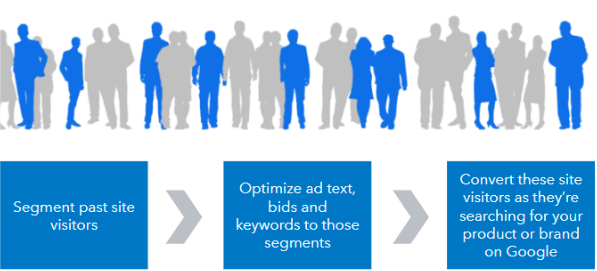Maximizing Patient Engagement: Remarketing in Healthcare

As someone who’s been in healthcare marketing for many years, I’m constantly surprised by how few medical organizations are utilizing the power of remarketing. Despite being around for over a decade, many healthcare providers still haven’t tapped into their full potential.
In this blog post, I want to explore why remarketing is so critical for healthcare and discuss the various strategies that can be employed to maximize its impact. From paid search to paid social, programmatic to display remarketing, we’ll cover it all. By the end of this article, you’ll have a deeper understanding of how remarketing can help your healthcare organization reach its target audience and improve patient engagement. So, let’s dive in and explore how emagineHealth can help bring expertise to your retargeting strategy.
Understanding Remarketing in Healthcare
If you’re new to remarketing, it’s a marketing strategy focusing on re-engaging users who have previously interacted with your brand, products, or services. In the healthcare industry, remarketing can be particularly beneficial. It helps medical organizations reach patients who have shown interest in their services but may have not yet taken action or followed through with a consultation or appointment.
Paid Search
Paid search remarketing, also known as search retargeting, is a technique that involves displaying ads to users who have previously visited your website. In contrast, they search for relevant keywords on search engines. This approach can be incredibly effective in the healthcare industry. It helps medical organizations re-engage users who have expressed interest in their services.
However, there are a few challenges that healthcare marketers should be aware of, such as navigating the complex landscape of medical advertising regulations and ensuring patient privacy. To overcome these challenges, following industry best practices and working with a trusted partner like emagineHealth, who can help you create and manage compliant and effective paid search remarketing campaigns, is essential.

Paid Social
As the name suggests, paid social remarketing involves displaying ads to users on social media platforms, such as Facebook, Instagram, and LinkedIn. This approach is beneficial in the healthcare industry, as social media platforms offer extensive targeting options and allow for the delivery of highly relevant ads to your target audience.
However, just like paid search remarketing, healthcare marketers must navigate the complex world of advertising regulations and patient privacy concerns. To create successful paid social remarketing campaigns, following industry best practices, such as eye-catching visuals, concise messaging, and engaging calls-to-action, is crucial.
Programmatic
Programmatic remarketing involves using automated technology to purchase and display ads to users who have previously interacted with your healthcare organization. This approach offers numerous benefits, such as increased efficiency, greater control over ad placements, and real-time optimization campaigns.
Yet, just as with other remarketing techniques, healthcare marketers must consider the unique challenges associated with the industry, such as patient privacy and compliance with advertising regulations. To optimize your programmatic remarketing campaigns, it’s essential to work with a partner like emagineHealth, who can help you navigate the complexities of the healthcare industry and ensure the success of your campaigns.
Display
Display remarketing involves showing banner ads to users who have visited your healthcare organization’s website or engaged with your brand online. These ads can be displayed on various websites and platforms, making it easier to reach your target audience.
While display remarketing offers numerous benefits, such as increased brand visibility and improved user engagement, healthcare marketers must know the industry’s unique challenges, including patient privacy and advertising regulations. To create successful display remarketing campaigns, following best practices, such as using high-quality visuals, engaging messaging, and clear calls to action, is essential.
Retail Media
Retail media remarketing for healthcare refers to using advertising platforms owned by retailers to target users who have interacted with healthcare-related products or services. The “what” of retail media remarketing for healthcare involves leveraging data collected by retailers to target users who have shown an interest in healthcare products or services, such as prescription drugs or medical devices.
The “how” involves setting up campaigns on retail advertising platforms, such as Amazon or Walmart, targeting users based on their previous interactions with healthcare products or services.
The “why” of retail media remarketing for healthcare is to reach a highly targeted audience of users who have already shown an interest in healthcare products or services, thereby increasing the likelihood of converting them into customers.
By leveraging the vast data retailers collect, healthcare companies can create highly targeted and effective advertising campaigns that maximize their ROI and reach their ideal audience.
Measuring Remarketing Success
When measuring the success of your healthcare remarketing campaigns, it is important to track several key performance indicators (KPIs) to gauge their effectiveness. Here are some of the most important KPIs to monitor:
- Click-Through Rates (CTR): CTR measures the number of clicks your ads receive divided by the number of impressions served. A high CTR indicates that your ad is relevant and engaging to your audience.
- Conversion Rates: Conversion rates measure the percentage of users who click on your ads and then take the desired action, such as filling out a form or making a purchase.
- Cost per Acquisition (CPA): CPA measures the cost of acquiring a new customer. By dividing the total cost of your ad campaign by the number of new customers acquired, you can determine your CPA.
- Return on Ad Spend (ROAS): ROAS measures the revenue generated from your ad campaign compared to the cost of the campaign. It is calculated by dividing the revenue by the ad spend.
When analyzing the results of your healthcare remarketing campaigns, it is important to consider some key factors that may affect the metrics. These include:
- Targeting: Are you targeting the right audience? Make sure to refine your targeting parameters to reach the most relevant audience for your healthcare products or services.
- Ad Creatives: Are your ad creatives effective and engaging? Make sure to test different variations to see which ones perform best.
- Landing Pages: Are your landing pages optimized for conversions? Ensure that your landing pages are clear, relevant, and easy to use.
- Budget: Are you allocating your budget effectively? Make sure to monitor your ad spend and adjust your budget as needed to optimize your ROI.
By tracking these KPIs and considering these factors, you can optimize your healthcare remarketing campaigns for maximum success. Working with a trusted partner like emagineHealth can provide you with valuable insights and recommendations for further optimization, helping you to achieve your marketing goals and improve your ROI.
Remarketing in healthcare can be a powerful tool for medical organizations, offering numerous benefits such as increased patient engagement, improved brand visibility, and better return on investment. Healthcare marketers can use paid search, paid social, programmatic, and display remarketing strategies to create highly effective campaigns that target and engage their desired audience through their wellness journey.
Privacy and Compliance in Healthcare Remarketing
As mentioned earlier, healthcare remarketing comes with its own unique challenges, particularly regarding patient privacy and compliance with industry regulations, such as the Health Insurance Portability and Accountability Act (HIPAA). To ensure the success of your remarketing campaigns and avoid potential pitfalls, it’s crucial to work with a knowledgeable partner like emagineHealth, who can help you navigate these complex issues and ensure your campaigns remain compliant and effective.
These restrictions on retargeting exist for Google and other ad platforms for several reasons. For example, Google’s healthcare and medicines policy prohibits retargeting based on a user’s search queries related to healthcare or medical conditions.
This is to protect user privacy and prevent sensitive health information from being used for ad-targeting purposes. Similarly, ad platforms must comply with regulations set forth by HIPAA, which sets strict guidelines for the use and disclosure of patient health information. Therefore, healthcare organizations must navigate these restrictions and ensure their remarketing campaigns comply with relevant regulations to achieve the desired results.
- Patient Privacy: One of the primary concerns for healthcare advertising is ensuring the privacy and confidentiality of patient’s personal and medical information. Retargeting can reveal sensitive health information, such as a user’s medical condition or treatment, which would violate privacy regulations like HIPAA in the United States.
- Misleading or Inaccurate Information: Healthcare is a highly regulated industry, and the provision of accurate and reliable information is crucial. Retargeting ads that promote specific medications or treatments may spread misleading or inaccurate information, potentially causing harm or creating confusion for patients.
- Vulnerable Audiences: Some users targeted by healthcare remarketing campaigns may be vulnerable or experiencing emotional distress due to their medical condition. Ad platforms want to ensure that these individuals are not exploited or subjected to inappropriate advertising that could negatively impact their mental well-being.
- Compliance with Regulations: Healthcare advertising must comply with a range of regulations, including FDA (Food and Drug Administration) guidelines in the United States, which govern the promotion of prescription drugs and medical devices. Ad platforms must ensure that advertisers adhere to these regulations to avoid legal ramifications and protect user safety.
- Ethical Concerns: Healthcare advertising raises ethical concerns about the influence of marketing on patients’ medical decisions. Ad platforms need to balance allowing advertisers to promote their products and services while ensuring that users receive reliable and unbiased information to make informed healthcare choices.
The restrictions on healthcare retargeting exist to protect patient privacy, maintain the accuracy and reliability of medical information, ensure compliance with regulations, and address ethical concerns related to healthcare marketing. These restrictions are in place to safeguard users’ best interests and promote responsible advertising practices within the healthcare industry.
By partnering with a trusted expert like emagineHealth, you can ensure the success of your remarketing campaigns and reap the rewards of this powerful marketing technique.
So, whether you’re just getting started with remarketing in healthcare or looking to improve your existing campaigns, don’t hesitate to reach out to emagineHealth and discover how our expertise can help you achieve your marketing goals.

Creative Healthcare Remarketing Solutions Beyond Google Ads
While Google Ads is undoubtedly a popular choice for many healthcare marketers, there may be situations where retargeting on this platform isn’t feasible or practical. But fear not; plenty of creative solutions are available for advertisers who want to make their mark without relying solely on Google Ads. In this article, we’ll explore alternative strategies and platforms to help you effectively reach your target audience and comply with industry regulations. So, let’s dive in and discover the world of healthcare remarketing beyond Google Ads.
Leverage Content Marketing and Email Remarketing
One of the most effective ways to engage users who have previously interacted with your healthcare organization is through content marketing and email remarketing. Creating valuable, informative, and engaging content can educate your audience about your services, address their concerns, and nurture their interest.
Additionally, by using email remarketing, you can send targeted messages to users who have shown interest in your content or services, encouraging them to take the next step in their healthcare journey. Just be sure to follow email marketing best practices and comply with patient privacy regulations, such as HIPAA.
Explore Alternative Ad Networks
While Google Ads may be the most well-known advertising platform, several alternative ad networks offer similar remarketing capabilities, such as Microsoft Advertising (formerly Bing Ads), Yahoo Gemini, and Amazon Advertising. These platforms can provide healthcare marketers additional channels to reach their target audience and re-engage users who have previously interacted with their brand.
Utilize Social Media Advertising Platforms
As mentioned previously, social media platforms like Facebook, Instagram, LinkedIn, and Twitter can be powerful tools for healthcare remarketing. By leveraging the extensive targeting options and ad formats available on these platforms, you can create highly relevant and engaging remarketing campaigns that resonate with your audience. Follow each platform’s advertising guidelines and comply with healthcare industry regulations.
Partner with Healthcare Influencers
Influencer marketing has become increasingly popular in recent years and can be an effective strategy for healthcare remarketing. By partnering with healthcare influencers who share your target audience, you can tap into their credibility and reach while providing valuable content and resources to their followers.
When selecting influencers to work with, look for those who align with your brand values and have a genuine connection with your audience. Additionally, ensure that your partnerships comply with industry regulations and disclose any sponsored content according to FTC guidelines.
Use Geofencing and Location-Based Advertising
Geofencing and location-based advertising can be a powerful way to reach users who have previously visited your healthcare organization or attended relevant events, such as health expos or conferences. By targeting users based on location, you can deliver highly relevant and timely ads that encourage them to re-engage with your brand.Just be sure to follow location-based advertising best practices and maintain compliance with patient privacy regulations, such as HIPAA.
While Google Ads may be a popular choice for healthcare remarketing, there are plenty of creative and effective alternatives for advertisers looking to expand their reach and engage their target audience. You can create a diverse and robust remarketing strategy that delivers results by exploring content marketing, email remarketing, alternative ad networks, social media advertising platforms, influencer partnerships, and geofencing.
Remember, the key to success in healthcare remarketing is to follow industry best practices, maintain compliance with regulations, and continuously optimize your campaigns. So, feel free to think outside the box and explore new opportunities to engage and convert your audience while keeping their best interests at heart.
How to Do This Example: Remarketing for a Low Cholesterol Drug Using Google Ads and Facebook
Pharmaceutical companies face unique challenges in remarketing, especially with restrictions placed by advertising platforms like Google Ads and Facebook. However, with the right strategies and a thorough understanding of each platform’s guidelines, it is possible to create effective remarketing campaigns for patients interested in a low-cholesterol drug.
In this how-to guide, we will explore the steps you need to take to create successful remarketing campaigns on Google Ads and Facebook while overcoming the restrictions placed by these platforms.
Step 1: Understand the Advertising Policies for Google Ads and Facebook
Before starting your remarketing campaign, it is essential to familiarize yourself with the advertising policies of both Google Ads and Facebook. These platforms have specific guidelines for promoting prescription drugs. Understanding these policies will help you stay compliant and avoid potential issues.
Google Ads: Google has strict policies regarding healthcare and medicine advertising. They generally do not allow remarketing for prescription drugs. However, they may enable contextual targeting, which involves displaying ads based on the content of the website being viewed rather than targeting specific users.
Step 2: Develop a Contextual Targeting Strategy on Google Ads
Since Google Ads does not allow remarketing for prescription drugs, you will need to focus on contextual targeting. Here’s how to set up a contextual targeting campaign:
- Sign in to your Google Ads account and create a new Display campaign.
- In the “Settings” tab, choose the “Placements” option.
- Instead of selecting specific websites, choose the “Topics” option. This will allow you to target websites with content related to your low-cholesterol drug.
- Select relevant topics such as “Cholesterol,” “Cardiovascular Health,” or “Heart Disease Prevention.”
- Create compelling ad creatives highlighting the benefits of your low cholesterol drug while adhering to Google Ads’ advertising policies.
Facebook: Facebook’s advertising policies also restrict the promotion of prescription drugs. However, they allow advertisers to promote online pharmacies with prior permission and promote awareness campaigns related to prescription drugs.
Step 3: Create a Facebook Awareness Campaign
Since Facebook allows advertisers to promote awareness campaigns related to prescription drugs, you can create an awareness campaign targeting patients who may be interested in your low-cholesterol medicine. Here’s how:
- Sign in to your Facebook Ads Manager and create a new campaign.
- Choose the “Brand Awareness” or “Reach” objective, depending on your goals.
- Define your target audience based on demographics, interests, and behaviors relevant to your low-cholesterol drug.
- Create engaging ad creatives that raise awareness about your drug and the importance of managing cholesterol levels.
- Monitor your campaign’s performance and optimize it for better results.
Step 4: Leverage Facebook Groups for Patient Engagement
While remarketing may be restricted on Facebook, you can still leverage Facebook Groups to engage with potential patients interested in managing their cholesterol levels. Creating or joining relevant groups allows you to share valuable content, answer questions, and build trust with your target audience.
- Search for existing Facebook Groups related to cholesterol management, heart health, or cardiovascular disease prevention.
- Request to join these groups as a pharmaceutical company representative or create a group to share information and resources related to your low cholesterol drug.
- Share valuable content, such as blog posts, infographics, and videos, that provide helpful tips and insights on cholesterol management.
- Engage with group members by answering questions, addressing concerns, and providing support.
While remarketing for prescription drugs is restricted on platforms like Google Ads and Facebook, pharmaceutical companies can still effectively target and engage their audience by focusing on contextual.
Amplify your Healthcare Marketing Strategies
Navigating the complex landscape of medical advertising regulations and ensuring patient privacy can be challenging. To overcome these challenges, following industry best practices and working with a trusted partner like emagineHealth, who can help you create and manage compliant and effective paid search remarketing campaigns, is essential.
For more information on remarketing in the healthcare industry, get expert help from emagineHealth. Let’s get started.

Paid Digital Media for Healthcare & Biopharma
In our newest ebook, Paid Digital Media for Healthcare & Biopharma, we discuss how to get in front of your ideal audience, the importance of targeting the patient and HCP journey, how to determine which platforms to focus on, and more.